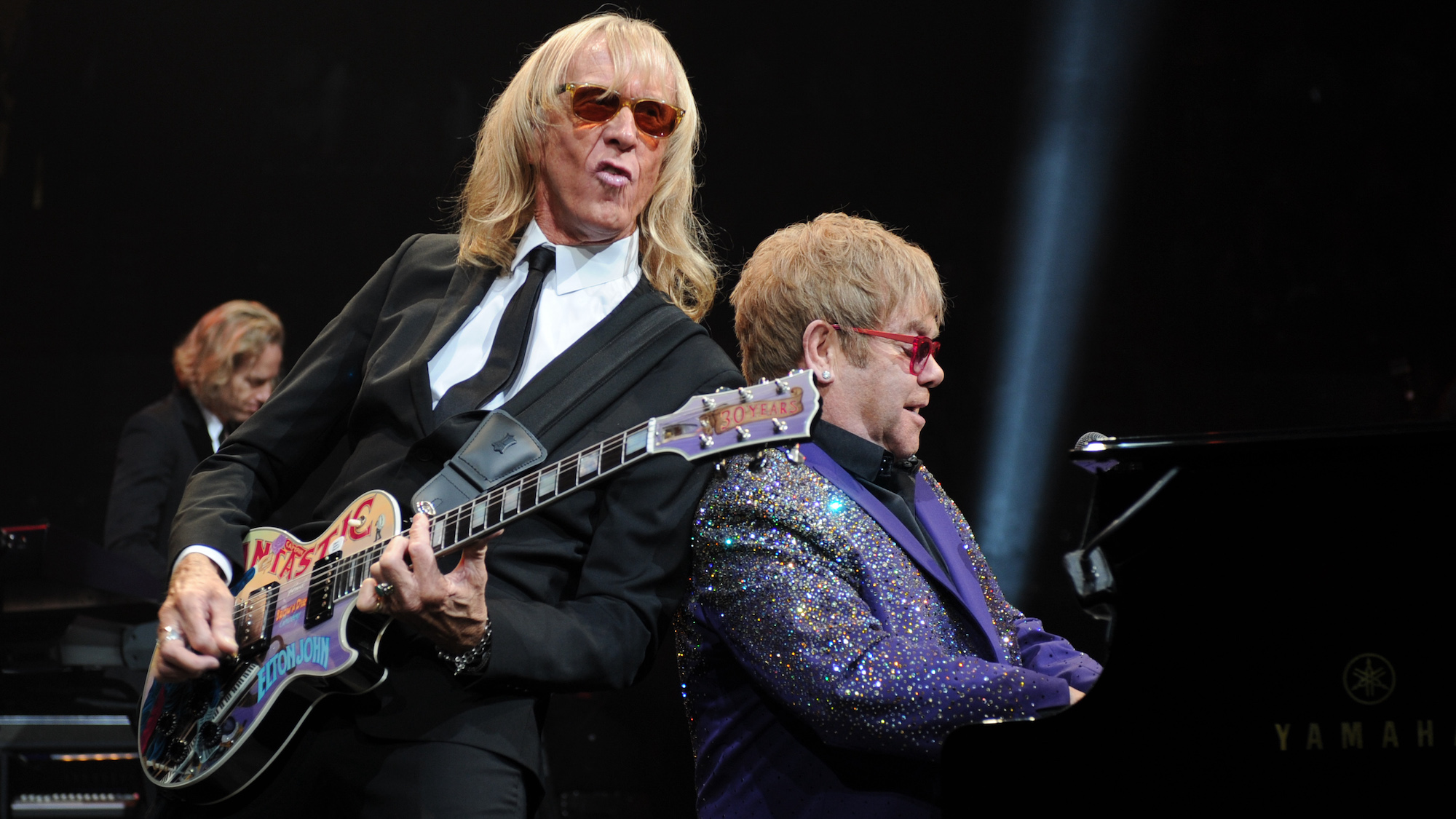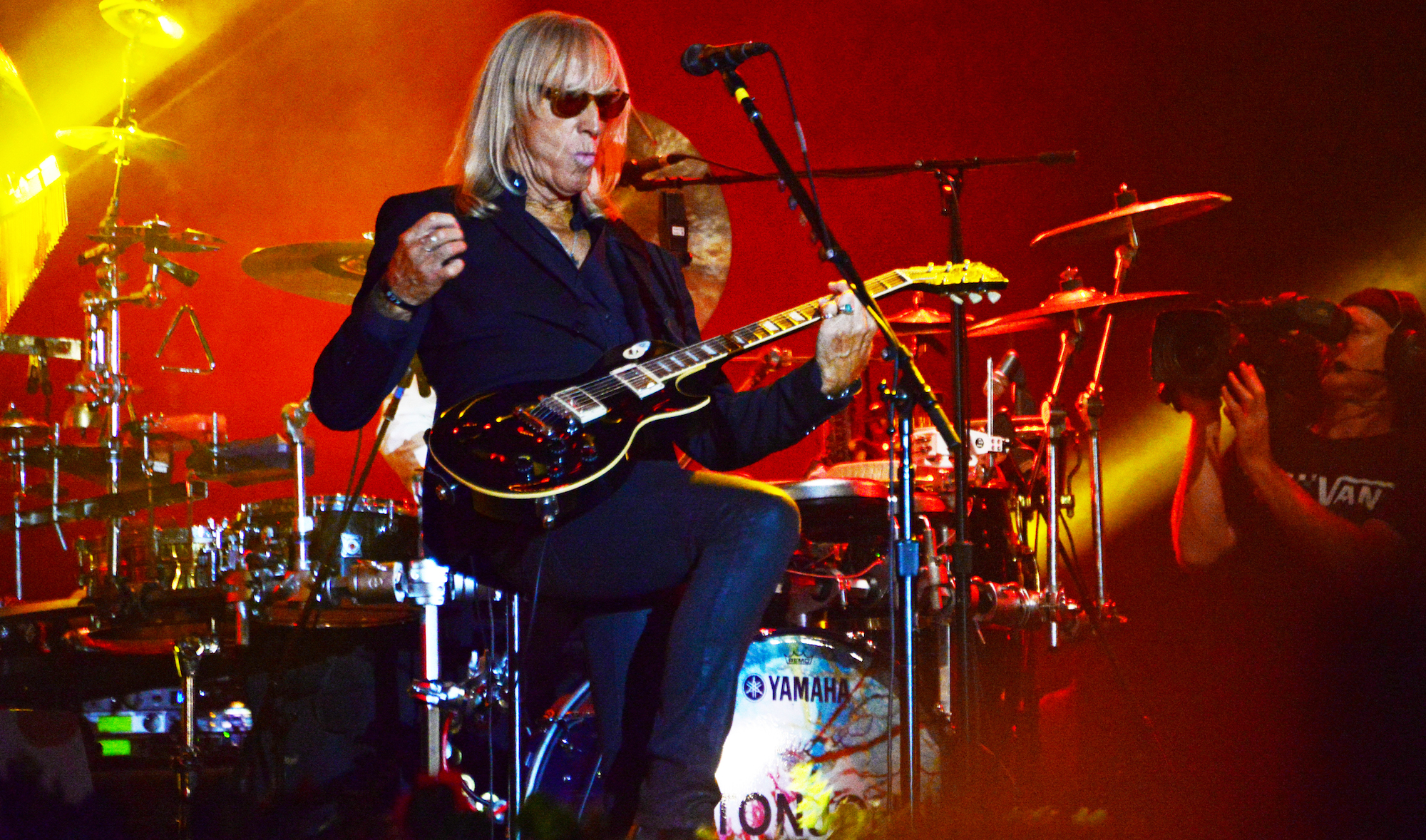“When I went to my first meeting with Elton, I immediately hit him with ideas. Elton saw my willingness to put myself out there”: Elton John guitarist Davey Johnstone reveals how learning the sitar benefited his guitar playing, and how (not) to get a gig

In the late 1960s, Davey Johnstone was a 17-year-old folk-based guitarist when he left his hometown of Edinburgh to try his hand at the London rock and roll session scene. What he lacked in experience, he made up for in confidence and tenacity.
“I was entering a whole new world, but I was convinced that I belonged there,” he says. “If I walked into a recording studio and somebody asked me if I could play something, I immediately said, ‘Of course I can.’ I didn’t say no to anything.”
Give the man his due: The 72-year-old guitarist knows a thing or two about getting – and keeping – a gig.
Last year, he wrapped Elton John’s Farewell Yellow Brick Road tour, bringing an end to his half-century-plus tenure in the singer’s band.
“None of it would have happened if I doubted myself,” Johnstone says. “When I went to my first meeting with Elton, back when he was recording Madman Across the Water, I immediately started hitting him with ideas. Elton saw my willingness to put myself out there. He saw that I wanted to be a part of what he was doing. Another guy my age might have been too timid to say anything, but that person wouldn’t have gotten the gig.
“Fear can stop you from doing most anything in life,” he continues. “But it’s an absolute killer if you want to be in the music business. I’ve seen guitarists audition for a gig or session, and say, ‘I can’t do that.’ Right then and there, their chances of getting hired have gone right out the window. You have to walk into a room like you belong there. Never say that you can’t do something – chances are you can do it, but you just haven’t tried.”
Johnstone admits self-belief is only part of the picture. “If you’re going to have a real career in this business, you still have to back it up. You’ve got to have the goods,” he says. “The key to that is by being a versatile, well-rounded guitarist who is curious and likes to explore all that music has to offer.” To that end, he has a few pointers.
1. Consider a volume pedal
“I’ve always loved the effect you can get from using one. I fell in love with the sound the first time I heard George Harrison using one on I Need You. Once I knew what it was and I had a bit of money to afford some equipment, a volume pedal was the first thing I bought.
“Beyond its sound, it’s useful in other ways and has become an important tool for me. If I have to change presets from a really clean sound to a huge overdriven sound, it reduces the embarrassing pops and farts I might otherwise get. Also, when I’m recording, I can cut the sound if I’m not playing. That way, an engineer doesn’t have to hear this annoying hum from my guitar.
“Some players like to use their pinkie on their guitar’s volume knob. If that way works for you, go for it. But with a volume pedal, I can use my hands for playing.”
2. Think beyond standard tuning
“Open tunings are a massive part of my musical vocabulary. I’m Scottish and I’ve always heard Celtic music and bagpipes, which, of course, use a lot of droning sounds. I stumbled onto my first open tuning when I tried to play a traditional Scots ballad, but I couldn’t get the sound I wanted on a guitar in standard tuning.
“I actually made up my first opening tuning just by messing around and trying to figure out how I could play a melody on the top two strings while I got a beautiful, ethereal drone on the remaining strings.
If you start using your fingers, you can create phenomenal textures that are quite different than what you achieve with a pick
“I’ve always been adventurous. When I was 13, I got a 12-string guitar and started using open tunings on that. Talk about brilliant sounds! I’ve experimented with Keith Richards’ open G tuning. Now, he tunes his A string down to G and then he removes the low E string, and the high E is tuned down to D. What I do is, I leave the low E on, but I tune it up to G.
“It’s dangerous – you think you’re going to pop the string or damage your bridge – but it’s an incredible sound with those two low G strings. I’ve used that tuning on quite a few songs, like our version of Pinball Wizard [from the soundtrack to Ken Russell’s 1975 film adaptation of Tommy]. Listen to those opening chords.”

3. There are other stringed instruments you can play
“Growing up in Scotland, I played a lot of different types of music, and I also learned instruments other than the guitar. I started playing violin when I was seven, and I think it gave me an expanded knowledge of the fingerboard. It also helped my intonation, which came in handy on the guitar.
“Indian music called to me after I heard what George Harrison and Brian Jones were doing with the sitar. I searched out an album by Ravi Shankar and the great violinist Yehudi Menuhin called East Meets West, and it blew me away. The combination of sitar and violin was unbelievable. I thought, ‘I want to be able to do that,’ and I bought a sitar. I was able to take my understanding of the guitar and other stringed instruments and develop it even further by playing sitar.
“By the time I was 15, I was playing banjo, mandolin, violin, guitar, and sitar, so I was a multi-instrumentalist. This served me well a couple of years later when I moved to London and started doing sessions. If somebody said, ‘We need a mandolin part here,’ somebody else would say, ‘Hey, what about that little Scottish kid?’
“In fact, the second song I cut with Elton was Holiday Inn. He played me the song on piano, and I said, ‘That’s great. How about mandolin?’ He loved the idea. I played mandolin on the track and two sitars on the solo. My ability to play other instruments came in handy on my first day with Elton.”
4. Flesh out your sound with your fingers
“Fingerpicking has allowed me to create a more rounded sound than if I only relied on a pick. As a young player, I started learning fingerstyle from listening to Bert Jansch. I was also a massive Beatles fan, and I started to notice on later Beatles records, certainly on the White Album, John Lennon’s fingerpicking added so much to the mood and sound of the songs.
“Dear Prudence – he played fingerstyle on his Casino, and it sounded so amazing and hypnotic. Then on Here Comes the Sun, George’s fingerpicking is gorgeous.
“These songs meant a great deal to me, and they got me into fingerpicking. Not that you can’t play wonderful parts with a pick – of course you can. But if you start using your fingers, you can create phenomenal textures that are quite different than what you achieve with a pick. And it’s free – you don’t have to buy any gear.”
5. Use your pop instincts when soloing
”I’ve never wanted to simply ‘fill the space’ when I play a solo. I want to complement the song and be an integral part of it. If I’m playing rhythm or doing little fills, I want to create sounds and patterns that move the song along and don’t step all over it. Then, when it’s my time to shine with a solo – if it’s really necessary – I think about what really matters.
”I imagine the audience hearing the song. I want to give them something they can remember. A good guitar solo should be something a listener can sing back to you.
”I’ve had people tell me they can sing my solos, which is incredibly gratifying. Instead of thinking like a guitarist when I solo, I like to think like a composer. To that end, I suggest that guitar players try to sharpen their pop instincts – it will enable them to play the right thing at the right time. Your note choices will improve. You’ll play melodies and parts that stick to the song.
”Once you tune into your pop instincts and get out of the mindset of ‘look at me,’ you’ll start to play really effective solos quickly and spontaneously. Most of my best solos are one or two takes – your first instincts tend to be simpler ideas, and those are the things that people can sing. Once you start fiddling around too much, the feeling goes away.”
- The Davey Johnstone Band's Deeper Than My Roots album can be purchased here
Get The Pick Newsletter
All the latest guitar news, interviews, lessons, reviews, deals and more, direct to your inbox!

Joe is a freelance journalist who has, over the past few decades, interviewed hundreds of guitarists for Guitar World, Guitar Player, MusicRadar and Classic Rock. He is also a former editor of Guitar World, contributing writer for Guitar Aficionado and VP of A&R for Island Records. He’s an enthusiastic guitarist, but he’s nowhere near the likes of the people he interviews. Surprisingly, his skills are more suited to the drums. If you need a drummer for your Beatles tribute band, look him up.
“That's enough to make anybody who writes songs want to retire." Mark Knopfler on his difficult collaboration with his childhood hero, Bob Dylan
“I knew he was going to be somebody then. He had that star quality”: Ritchie Blackmore on his first meeting with Jimmy Page and early recording sessions with Jeff Beck










